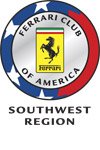
Ferrari?s First Four-Cylinder Sports Cars
Reprinted by permission of the Ferrari Market Letter
Roush Publications, Inc.
Legend has it
that is was the exploits of a certain Stirling Moss, racing in 1950 and 1951 with an HWM
Formula 2 powered by an Alta 4-cylinder engine against Ferrari?s V-12 formula 2 cars,
that first alerted the folks at Maranello to the beneficial characteristics inherent in
the 4-cylinder layout. As was customary at Ferrari a promising innovation was to be tried
first in a monoposto race car, and by the end of 1951 Ferrari had a 2-liter 4-cylinder
(i.e. 500cc per cylinder) Formula 2 car ready. When Formula 2 took Formula1?s World
Championship status for the 1952 season the 500 Formula 2 Ferrari was virtually
invincible, easily winning the championship.
It should come as no surprise that an attempt was made to transplant this success into the sports cars. The first two such cars made their public debut on June 29, 1953 at the 6th Gran Premio dell?Autodromo at Monza. this event was for sports cars of no more than 3,000 cc displacement. Among the Ferraris entered were two 4-cylinder prototypes - a 735 S, displacing 2,940 cc for the reigning World Champion Alberto Ascari; and a 625 TF, displacing 2,500 cc for the promising Englishman Mike Hawthorn.
Both cars had engines that were developments of the very successful Formula 2 powerplant, and retained that engine?s basic architecture. Being prototypes exact details are sketchy. Dual overhead camshafts, driven by a train of gears rather than using the V-12?s chain drive, actuated two valves per cylinder. As with the "long block" Lampredi-designed V-12 the cylinder liners screwed into the cylinder heads, eliminating the head gasket. The solid-billet crankshaft used five main bearings of the Vandervell thin-wall design, as were the rod bearings.
Lubrication was by a dry sump system; the ignition system used two plugs per cylinder fired by dual magnetos (some sources say distributors); and two twin-choke sidedraft carburetor supplied the fuel mixture (various sources cite various sizes). Both engines had a 90 mm stroke, with the smaller one having a 94 mm bore and the larger on a 102 mm bore. Both are usually claimed to have 9:1 compression ratio, and to have produced 220 to 225 horsepower.
The confusion concerning engine specifications seems rather tame compared to chassis details. Most sources dismiss the cars has having been, basically, either contemporary 250 MM or 166 MM/53 chassis into which 4-cylinder engines were dropped. But wheelbase dimensions have been given as 2160 mm; 2250 mm; and 2400 mm.
Probably both chassis were constructed in the fashion characteristic of Ferrari at the time -- two large longitudinal tubes connected by tow main cross members and various other tubes of smaller diameter. Front suspension would have been independent, using unequal length A-arms and a transverse leaf spring. At the rear a de Dion axle was probably used, likewise with a transverse leaf spring. The gearbox would typically have been a transaxle unit, mounted at the rear and fitted with four forward speeds plus reverse. Large finned drum brakes and Houdaille lever-actions shocks would complete the package.
The 735 S is shrouded in even more mystery. The bodywork was quite unusual, and is generally attributed to a design by Aurelio Lampredi as executed by Carrozzeria Autodromo of Modena. But there are those who insist that the body was actually fabricated in Ferrari?s own workshops. Two Ferraris given similar bodywork were both V-12 166 MM/53?s, S/N 0264 M and 0272 M. No 4-cylinder car with this style body is known to exist today, and the S.N of the 735 S is not known. 0428 and 0444 have been proposed. But these two<
